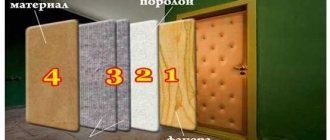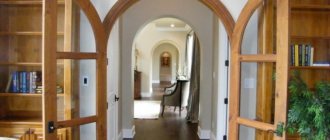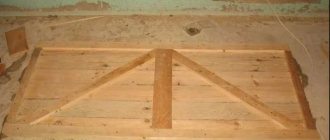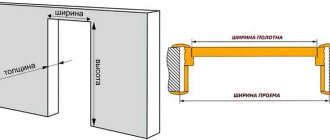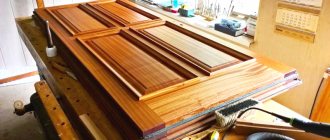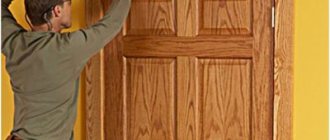Foam plastic: advantages and features of the material
A homemade polystyrene arch is often found in apartments and private houses.
Despite the fact that the opening is made using plasterboard or plywood, this material is ideal for those who want to quickly design an arch with their own hands. The advantages of polystyrene foam include:
- Price. The material is available and costs a penny compared to the same drywall.
- Transportation. Foam blocks can be easily carried by one person, and there is no need to hire transport for this.
- Weight. In dangerous buildings, every extra kilogram can cause harm. The lightness of the material allows it to be used even on flimsy structures.
- Flexibility to processing. You can shape it using a knife and a grinder.
In addition, this material is unpretentious when fastening and can be glued to the wall with any substance that will ensure proper adhesion of the future arch. There are several points that must be taken into account before constructing such a structure with your own hands.
Firstly, the arch will be fragile. Even despite the surface layer of plaster, it is necessary to avoid strong impacts on the structure. Otherwise, part of the arch will crumble.
Secondly, the presence of lighting fixtures in the arch or other heat sources nearby is excluded. Polystyrene foam is highly flammable, so do not neglect fire safety rules.
Thirdly, you need to carefully approach the choice of the material itself. This is due to the fact that low-quality foam is found on the market. And such material is intended for use outside or inside non-residential premises, as it contains toxic substances in its composition. Their evaporation and entry into the body causes health problems. Therefore, check the information with the seller.
Decorated foam arch
Design of a thermal vestibule ↑
In a private house, an attached heated or insulated vestibule saves the iron entrance door from freezing and icing. In areas with significant sub-zero temperatures, this option is considered the most acceptable.
Previously, houses always had canopies that protected the entrance door to the living space from the penetration of cold street air. Now the canopy is called a vestibule or veranda. Don’t reinvent the wheel when thinking about how to insulate a metal front door in a cottage. Immediately build a house with a spacious built-in vestibule.
Mini vestibule in the cottage
Mini vestibules formed during the installation of double doors also have a positive effect on the thermal insulation of the room. This method is suitable for apartments located on the first floors, where it is always cold. The first door is made of metal, and the second is made of wood. In this case, both doors must be well insulated. In this case, the air gap serves as an additional heat insulator.
A properly insulated iron door installed at the entrance to the house will protect against cold and noise. Technologies that eliminate condensation on metal surfaces of the entrance group will save materials from premature aging. If you cannot figure out how to insulate metal entrance doors with your own hands better and more reliably, then use the services of professionals.
Scheme of work
Complete door measurement Laying insulation Finishing cladding
- The door leaf is measured. These dimensions are transferred to the insulation with a slight deviation of one centimeter to the smaller side. For example, the width of the canvas is 110 cm, which means you will need insulation 108 cm wide. Minus one centimeter on both sides.
- The same size is transferred to the upholstery material with an allowance of 3-5 cm on each side. That is, it should be 120 cm wide.
- Now remove the wooden entrance door from its hinges and place it on a flat surface - it can be a table, two chairs or a trestle.
- Remove all the fittings from it. This is not difficult to do.
- Lay the insulation so that there are free areas along the edges of the canvas. Their size will be 1 cm.
- Now the sheathing is laid on top of the insulation. Its edges are folded inward and pierced with small nails. Instead of nails, you can use metal staples, which are driven in using a stapler. Fastening must be carried out in those free areas, which is why the insulation was cut to a smaller size.
- When attaching the trim, it is necessary to constantly tighten the material so that folds do not form on the door. Remember that the sheathing material must be fastened from the middle, going along the edges to the end.
- After the wooden door trim is finished, it is necessary to make a hole in the place where the lock and handle are installed and install the fittings.
- Now let's return to the rollers. That is, there must be a complete set - sheathing and bolsters. In this case, they must be installed. Please note that the lower roller should fit snugly against the threshold. All others should stick out from the edge of the canvas by 4-5 cm.
- Now to the question of the appearance of a paneled wooden door. Making a small pattern on the door leaf with your own hands is not a problem. To do this, you can draw a design with chalk and punch decorative furniture nails along the lines. In addition, you can stretch fishing line or copper wire between the nails. It turns out very beautiful.
- All that remains is to hang the wooden door on its hinges.
Cutting and laying insulation
The next stage of insulating the door leaf will be laying material that will make it warmer . To do this, you need to arm yourself with a stationery knife. Thermal insulation is cut to the length and width of the sheet so that there is no empty space left. If the door is a frame with voids, then they need to be filled with insulation.
The insulation is tightly inserted between the bars
All pieces must be tightly inserted between the bars to prevent the formation of cold bridges. At the same time, the material should not bubble, which would indicate an excessively large supply. In this case, it is worth cutting off a little excess material. Once everything is adjusted, you need to secure the insulation with staples. A construction stapler allows you to do this quickly and efficiently.
Insulation with polyurethane foam
You can install the arch with your own hands and without pre-treatment, but then there is a risk of visually making the room smaller and reducing the available space. Before starting work, take measurements of the opening. If it turns out to be less than two meters, then it is recommended to abandon the creation of the arch.
If a foam arch is made in place of a doorway, it will have to be expanded. To do this you will need to break through the wall at the top and sides. If possible, it is better to demolish the wall and install a new one, with the required dimensions and location of the opening.
It is important to take into account that only those walls that are not load-bearing can be demolished. Otherwise, the building plan will be disrupted, and the risk of an emergency will increase significantly.
Expanding a doorway under an arch
If necessary, remove the old door frame, align the edges of the opening, and remove strongly protruding parts of the wall.
Having decided on the shape, proceed to installation. First of all, you need to cut out the necessary parts from the material.
If the foam is in blocks, then it is recommended to cut the rounding gradually: first on one block, and then, by attaching the first one to it, on the second. First, parts that imitate a wall are cut out of lamellar foam. The resulting void between them is filled with polyurethane foam, but it is recommended to take the time to place the foam there. This will give the arched structure uniformity.
The placement itself occurs layer by layer. For reliability, it is recommended to secure the components with nails, and not just with glue. When the arch takes its final shape, they move on to finishing work.
First, the projections on the foam arch structure are either cut off or removed by hand. It's simple: the material crumbles in your hands.
Secondly, the surface is polished. You won't be able to achieve perfect smoothness with your own hands, but that's not necessary. Use a sanding machine, if available, carefully so as not to make a dent in the material.
https://www.youtube.com/watch?v=GfWXYTUIjb4
The putty itself is applied in the same way as on the wall. After drying, it is leveled, roughness is removed and decorated based on needs.
Foam gun
- Buy a foam gun, medium size.
- Apply construction tape to the border of the door, including the door itself, the frame and the wall.
- Fill the inner and outer perimeter of the door with polyurethane foam, making sure that there are no voids left between the door frame and the wall.
- Then use sandpaper and a knife to remove excess foam.
- At the end, the joints are puttied and painted to match the color of the walls of the house.
How to find where the cold penetrates
There can be several channels.
Canvas
It shouldn't be too cold. Under normal conditions, the inner plate is heated by the room. A surface with a low temperature, ice, frost and condensation are signs that the sash is conducting cold. The larger its area, the more intense the cooling of the room. One of the reasons is the low quality of lining and filling. Chinese and domestic manufacturers are trying to make their products accessible and supply kits at low prices. This affects the quality. Even if technical standards are met, the level of insulation may not be sufficient.
The layer installed from the inside may have defects. When wet, its throughput increases. Moisture gets inside if the production technology is violated or due to the lack of waterproofing, which protects the pores and fibers from steam in the air. Leaks occur through cracks between soft slabs.
Design: Elena Aldoshina. Photo: Mikhail Chekalov
Metal parts that hold the cladding panels and fittings also serve as channels. To understand whether they are the cause of surface freezing, you need to determine how much the temperature of the cladding changes as you move away from them. You may not have to look for new content. Before insulating the front door with your own hands, you should read the instructions and study the information on the warranty card. In most cases, after self-repair, the owner loses the right to warranty service.
Box
It is a frame installed in the opening in which the sash is fixed. It is covered from the inside with a sealing elastic tape. This tape is often glued to the sash. It acts as a damper and fills the space when closing. Drafts appear if it is too massive and rigid - then it interferes with complete closure. Voids are formed due to insufficient thickness and density, wear, and mechanical damage.
From the outside, the box is attached to the opening. The voids are filled with polyurethane foam. Even if the work was carried out correctly and there are no cracks left, the foam collapses over time. It has a limited service life. Service life is reduced if there is no protection from moisture. Penetrating into the pores, water destroys their walls when freezing. In conditions of increased dampness, mold appears.
Not only strong drafts, but also weak, imperceptible currents can significantly change the microclimate in the room. To detect them, you need to bring a burning candle. The movement of the flame will indicate which way the air flow is moving.
ShutterStock
Opening
In a country house or in a wooden rural house, the walls experience constant temperature and humidity deformations. When wet they increase in size. In hot summer weather, the wood dries and shrinks. As a result, the connections to the box become loose.
A house in the city is resistant to the external environment, but in old apartments the openings have to be repaired due to deterioration of the structures. Brick and concrete lose strength over time and begin to crumble. In city buildings with heated entrances, careful insulation is not required. It is needed to get rid of drafts.
Pixabay
Types of arches: active and passive
In modern design, many arched forms are used. A competent approach to selection will ensure the convenience of residents or visitors and will favorably emphasize the designer’s idea and the very concept of the interior.
In fact, there are two large groups of arches:
- active – with a complex shape;
- passive - with a simple form.
Each of them includes a number of species. Thus, the passive group of arched forms includes:
- classic - regular semicircle;
- ellipsoidal - flattened semicircle;
- portal - a sheathed rectangular opening.
Art Nouveau and Romantic arches are sometimes mentioned, but they are variations of the above forms.
The active group of arches has collected in its list the following types:
- eastern,
- trapezoidal,
- lancet.
When choosing a form, they rely both on the height of the ceilings and openings, and on the concept of housing. The oriental type is inappropriate in a small apartment, but in a spacious home it can easily add color to the room.
Advice from professionals
The following recommendations from experienced craftsmen will help you avoid common mistakes when insulating a wooden front door:
- It is more effective to use heat-insulating material on both sides.
- You should choose consumable components from trusted manufacturers.
- The selected material must have high performance characteristics.
- The outer cladding must be resistant to precipitation.
- Each stage must be treated with full responsibility.
In the video on how to insulate a door with leatherette with your own hands, you can get acquainted with some of the features of the work:
Methods for designing foam arched structures
As mentioned above, polystyrene foam is a fragile material not designed for loads. However, there are many ways to decorate this type of arch with your own hands:
- foam imitation stucco, columns;
- using textiles;
- wallpapering;
- paint coating.
Decoration using polyurethane foam elements is interesting, as they:
- have an affordable price;
- light;
- have different shapes
- made to order.
Polyurethane foam elements
With the help of such decorative elements, the arch is easily given the flavor of Greece or the Renaissance, and your own taste and preferences are revealed.
Example of a polyurethane foam arch
Decorating with textiles involves using fabric as a curtain. This approach allows you to decorate the arch and give it some functionality: you can separate one zone from another.
Another popular method is painting. It can be made with your own hands, which leaves room for imagination. To add an interesting texture, decorative plaster is used.
With the right approach, wallpaper will give the foam arch an original and unusual look. The main thing is not to overload the design with ornaments or rich colors.
Typically, metal doors are made of sheet material, welded at the sides with corners, that is, they have voids inside that need to be filled from the inside for additional insulation.
The insulation technology is as follows:
- We take the dimensions of the door leaf (width and length) according to which we will cut out the fiberboard panel to cover the foam layer.
- We transfer the dimensions of the door leaf, the location and dimensions of the peephole and handle onto the fiberboard plywood, and cut out openings for them.
- We apply the panel to the door, checking that all the marks are correct.
Insulating an iron door with foam plastic
- Using a sharp knife, we cut out sheets of styrofoam to glue them to the inside of the door leaf. This insulation is glued using silicone, which is applied in a dense, uniform layer over the entire surface.
- Now you can cover the foam with a fiberboard panel. We put a bit on the screwdriver and screw the fiberboard to the door leaf with self-tapping screws.
- The stiffening ribs of the metal door are made of a hollow tube; in winter it freezes and the effect of a “refrigerator” is obtained. To prevent this from happening, it is filled from the inside with polyurethane foam. To do this, a hole is made in the pipe with a drill, where foam is poured.
Attention! If you want to thoroughly insulate the wall, the cracks between the foam sheets can also be filled with polyurethane foam.
Tool
It is impossible to get the job done without the right set of tools. To create insulated wooden entrance doors you will need:
- Tape measure and pencil;
- Stationery knife;
- Hacksaw;
- Hammer;
- Screwdriver;
- A flat rod or metal meter;
- Mounting tool or nail puller;
- Construction stapler.
It is necessary to prepare tools and lining material.
If necessary, this set can be expanded, but for most operations it will be quite sufficient. It should be noted that a hacksaw can easily be replaced with an electric jigsaw. This tool allows you to get the job done with the same quality, but much faster. And if there is no screwdriver in the house, then you can take a simple drill. The main thing is that it has a reverse, which will allow you to unscrew any self-tapping screw or screw if necessary.
In addition to the tools, it is necessary to prepare the covering material. For most door panels, it will be enough to use leatherette, which has an attractive appearance. This material has good characteristics and wear resistance, so the canvas will not need to be repaired for a long time.
And if you like to do everything with your own hands, then we recommend you instructions on how to make a wooden entrance door.
Which insulation for the front door is better to choose?
There are several ways to insulate your front door for the winter, the best way is upholstery. The following materials are used for this:
- Polystyrene foam (expanded polystyrene) is a porous, moisture-resistant heat-insulating material that also dampens sounds well. It is best to choose dense foam plastic designed for insulating facades.
- Mineral wool is a non-toxic and non-flammable material that is manufactured in the form of finished panels. It is resistant to moisture, a good sound and heat insulator, easy to transport and install, and does not shrink. The only negative is that it can produce phenol that is harmful to humans, but only under the influence of high temperatures. It is not advisable to insulate metal doors with mineral wool.
Mineral wool - Honeycomb insulation or corrugated cardboard is a cheap insulation material used mainly in warm climates. It will not be able to protect the door from severe frosts.
- Isolon or polyurethane foam. Available in roll form, it is light in weight, has high insulation values (sound, heat) and is resistant to atmospheric influences.
- Felt is made from wool. Reduces the concentration of harmful vapors in the air, is harmless, despite the fact that it absorbs moisture well, does not lose its thermal insulation properties, and harmful bacteria do not grow in it.
Felt - Foam rubber is a universal heat-insulating material. They insulate both entrance and balcony doors. It is non-toxic, not afraid of moisture, inexpensive, but also short-lived. Available in the form of strips, slabs or self-adhesive tapes.
It may be noted that manufacturers of doors with thermal break use polystyrene as insulation. Such doors include the well-known line of “Nord” doors, which have positively proven themselves in the market, from the Moscow manufacturer of entrance doors “ProfMaster”.
Insulation of a wooden door
Insulation of a wooden door with mineral wool
Installation of insulation should be carried out only after possible defects have been eliminated and its condition has been analyzed. Otherwise, the presence of a malfunction will make the insulation work useless.
We recommend: Do-it-yourself biogas plant: diagrams, projects, 130 photos and video description of the operating principle
You should pay attention to the following points:
- Door hinges. Their weakening should be corrected by tightening the mounting screws.
- Sealing. If cracks and crevices appear in areas filled with polyurethane foam, their integrity must be restored. In some cases, you need to completely update the fill.
- Skew. If the product is in a skewed state and is difficult to open and close, you need to level the problem areas by sharpening them with a plane.
- Door details. It is better to be prepared to replace the peephole, bell and handle before starting work, so you should make sure that they are in good working order.
Having prepared the door for installation of insulation, you can proceed to the selection of tools and material necessary for the work.
What you will need to complete the process efficiently:
- Seal. It creates a seal between the door and the adjacent frame. In addition, it prevents cold from entering the room, also protecting from rain and snow. There are single, double and triple types. Rubber, plastic or silicone are used in its production. Installation of the seal can be done by fastening it with self-tapping screws or by gluing it.
Adhesive door seal - Thermal insulation. Many materials are suitable for it, including foam rubber, polyethylene, synthetic winterizer and extruded polystyrene foam. Once upon a time, industrial wool was also used for insulation, but the rapid loss of useful qualities made its use irrational. Current thermal insulators are reliable and durable, while performing their intended purpose better.
- Upholstery. Performs a decorative function as an external coating of insulating material. This is done using leatherette or leather substitute.
- Availability of furniture nails, fishing line and stapler.
Having collected all the necessary tools and materials, as well as eliminating the malfunctions, you can proceed directly to the insulation procedure itself.
We insulate the front door with foam rubber
To insulate a wooden front door, you can use foam rubber on the outside. To do this you need:
- Remove the door frame from its hinges and place it on a flat horizontal plane, such as stools. Then remove all protruding parts of the door (lock, eye hole, handle).
- Next, you need to make a base for the rollers necessary to plug the hole between the door and the frame. For doors opening outwards, 3 strips of leatherette 140 mm wide are cut out, of which the length of the first is equal to the length of the door, and the other 2 are equal to its width. Three strips are nailed with nails along the edge of the door frame, having first retreated 15 mm from the edge. The side on which the hinges are located is not upholstered. For doors that open inwards, 4 strips 140 mm wide are cut out and nailed on all sides.
- You need to make bundles of cotton wool with a diameter of 30 mm, wrap them in leatherette, nailed at the bottom, and nail the resulting roller at the very edge of the door.
- Next, foam sheets are laid on top of the door leaf.
Foam rubber
- You need to cut the canvas out of leatherette according to the parameters of the door, plus 10 cm on each side. Lay the leatherette on top of the insulation and nail it, first the side corners, and then the bottom and top
- Next, you need to make the remaining three rollers (this applies to doors that open outward) and nail them so that the upper edge of the upholstery overlaps the lower one.
- Then you can nail the panel along the entire perimeter, ending with the edge on which the loops are located.
Advice! You can decorate the door leaf by nailing nails with caps in a specific pattern. This method of “decorating” the door prevents the foam rubber from settling.
- At the end, you need to cut holes for all the protruding parts of the door, fasten the handle in place and you can hang the door back on its hinges.
Methods of insulation in an apartment or private house
There are several methods of insulation. Which one to choose depends on the type of structure and its location. Doors facing the street need more thermal insulation, and drafts will require the installation of a second panel.
Along the perimeter of the opening: sealing cracks in the door frame
For this installation method, you will need a sealant that is glued to the sealant or adhesive layer. To seal cracks in the door frame, you can use different types of sealant:
- Foam rubber is the most fragile of all. This material will last no longer than one season.
- Rubber - mounted on a rubber layer and has good operating characteristics.
- PVC - withstands temperature changes well and comes in various shapes. To install this material, you will need to make a groove in the doorway and use a screwdriver to push the PVC tape into it.
- Rubber is a fairly elastic and frost-resistant material.
The more elastic the seal, the more tightly it will be placed in the space of the doorway, ensuring that it is not blown through.
To measure the size of the seal, take regular plasticine, wrap it in a bag and place it in one of the cracks, and then close the door. You will receive a cast from which you can easily select the material of the desired configuration.
There are two ways to glue the tape:
- if the product is self-adhesive , then before gluing, degrease the door frame, remove the protective film and secure the seal from bottom to top;
- if there is no sticky base , use liquid nails or silicone sealant.
Upholstery
Insulation of the door leaf itself is especially important for metal structures. The procedure is as follows:
- We remove the canvas from the hinges, remove the removable fittings (handles, lock).
- We fasten the insulation with a furniture stapler every 15 cm.
- Upholstery with decorative material, secured with decorative nails.
- We return the canvas to its original place.
Don't forget to leave 5 cm of upholstery material for the hem. For upholstery use:
- skin;
- foam;
- bologna or leatherette.
The material is attached with liquid nails, starting from the top.
You can insulate in another way:
- We attach wooden slats along the edges of the canvas;
- We lay a layer of foam plastic between the slats;
- We decorate the structure with plastic or fiberboard.
Threshold
The threshold protrusion performs several tasks at once:
- closes cracks at the bottom of the door;
- provides thermal insulation;
- prevents the formation of condensation.
You can insulate the threshold in two ways:
- If the protrusion is made of plastic, use polyurethane foam. The structure is removed, the assembly seam is cleared of debris and filled with foam in several layers, then returned to its place.
- Installing a thermal damper. With this method, the threshold is also dismantled, and a heating cable is laid in its place. To control the mechanism, the thermostat is taken outside, and at the end of the procedure the threshold is set back.
We recommend: Calculation of an expansion tank for closed and open heating
Installation of the second canvas
In private houses and cottages, double doors are especially relevant. Installation of the second canvas is possible in two ways:
- On an existing door frame . This option is convenient when installing panels at the same time, as well as when the structures are made of the same material. Significant advantages of this technique are increased installation strength and speed of installation work.
- Separate installation - relevant when it is necessary to install a second leaf to an existing one or if the doors are made of different materials. To install an additional door, you need to assemble the box, then hang the canvas on it using a building level, and carefully seal it. The main condition for this is that the canvases must be identical in size.
Insulation of metal (iron) and wooden sheets
Heat loss can occur through the door leaf itself, as well as due to loose fitting of the doors to the door frame. Therefore, insulate the structure in two directions. The insulation of a door leaf depends on the material it is made of:
- Metal structures are sealed by filling the cavity inside the door frame with foam or cotton wool. The door must be opened, the cardboard filler removed and the void filled with insulating material, decorated with MDF panels or plastic.
- Wooden doors are sealed with flexible insulation. Since it is impossible to place insulation inside, the doors are sealed from the inside or outside. The location of the hinges and the direction in which the door opens are taken into account. The laid material is covered with film, then upholstered with leatherette, which is attached to decorative nails.
Important: The thickness of the insulation must correspond to the thickness of the door leaf. Otherwise you will have to change the locks.
Insulation of the entrance door opening includes insulation:
- door frame;
- door slopes.
In the first case, a polymer or foam sealant with an adhesive base is used. The tape is attached to a previously degreased surface.
The procedure for sealing slopes:
- dismantle the structure;
- we fill the vacated space with foam and lay soft insulation;
- We return the slopes to their original place.
The main mistake when installing a door frame is the use of low-quality foam, blowing it intermittently, leading to the penetration of drafts. To check if the foam is leaking air, simply hold a lighter to the mounting seam: if the flame fluctuates, replace the insulating material.
Insulation of entrance doors is necessary for comfort in the house and apartment. All work must be carried out comprehensively. The main task is to choose the right material for thermal insulation and follow the instructions proposed in the article.
How to use sealing gasket
A rubber gasket bridges the gap between the door frame and the door leaf. This gap remains even when the door is closed, and up to 20% of the heat escapes through it. To prevent this you need:
- Measure the perimeter of the door frame; this indicator will be equal to the length of the tape. The width is equal to the size of the contact point between the frame and the door leaf (rebate width), and the thickness is equal to the width of the gap between the door leaf and the door.
- We remove the paper that protects the sticky side from the sealing gasket and smooth it along the entire perimeter of the door frame rebate.
https://www.youtube.com/watch?v=097dFhDizIk
In this way, you can insulate the door by upholstering it with insulation and covering the joints with sealing tape. If these methods do not help, you need to check that the door leaf is installed correctly and that there are no holes in the foam used during installation.
Insulating the door to the balcony
The doors to the balcony should be insulated simultaneously. It is necessary to seal the slopes and insulate the fabric. Before thermal insulation begins, it is necessary to carry out assessment work to ensure the integrity of the door. You should also carefully inspect canopies and other fastenings.
The process of installing the rubber seal on the balcony door
Insulation of a plastic balcony door
A plastic door can be installed on the balcony. In this case, only the frame around the perimeter and the seams are insulated. If you finish finishing the entire door, then the appearance will not be very attractive. Suitable materials: felt, isolon, mineral insulation, synthetic winterizer. Before work, you need to carefully check the door for drafts and mark these places. These are mainly joints, an unregulated door system, and lack of sealing between the threshold and the slope.
If you use polystyrene foam for insulation, you need to order a team of craftsmen who will do it professionally. After this, the insulation is covered with reinforcing mesh, puttied and painted.
Using foam to seal cracks on the balcony
After several years of using a plastic door on a balcony, cold air leaks in - the reason for this is a worn out rubber seal. She changes easily. For the winter, the elastic band is treated with silicone oil. The door mechanism also needs to be adjusted. For the winter, it is worth making the fit of the canvas more tightly to the door frame. Make plastic panels around the balcony opening (window, door).
Insulation of a wooden balcony door
It is more difficult to insulate a wooden door, but it will be warmer. For this you will need building mixtures, tools, and upholstery material. When installing insulation, you must take into account the threshold. Expanded polystyrene is most suitable for it. To insulate the glass on the door, you need to use silicone, which does not allow cold air to pass through the micro-slits where the glass is inserted.
To insulate a wooden balcony door, you need to carry out the following manipulations one by one:
- You need to remove the paint and varnish from the door. Then inspect the door very carefully for cracks. If there are any, all defects that appear are repaired using putty.
- After this, the door must be removed from its hinges and laid horizontally. All fittings are removed from the door.
- The upholstery material is attached vertically to one side of the door with nails.
- Foam rubber is laid on the canvas.
It should be fixed. Double-sided tape may be suitable for this. Wooden door insulation scheme - Next, the upholstery material is stretched over the door. The upholstery should be fastened in increments of up to 20 cm.
- If the balcony is not glazed, the door must be insulated on both sides.
Installation of foam rubber door - After this, you need to cut strips of foam rubber, the width of which coincides with the width of the door leaf. It is necessary to make strips of upholstery material equal to the length and width of the door, the width of the strip is 15 cm.
- After this, the foam rubber is wrapped in upholstery material, creating a kind of cushion. They must be attached to the edge of the door using furniture nails so that they close the gap between the door leaf and the frame.
- After the work has been done, the door is installed in its place.
- The last step is to fix the fittings in place where they were.
Insulation of door gaps to the balcony
If you don’t want to insulate the wooden door to the balcony, then you can do it differently - order a plastic door; the craftsmen will install a new door and adjust it to the upcoming cold weather, and also provide advice on further operation.
Insulating the balcony door means ensuring warmth and silence in the apartment. At the same time, the appearance of the door will not lose its beauty and will not spoil the design of the room.
Installation of double doors
A good way to insulate your home is to install a double entry door. Due to the formation of an air space separating the room from the street, heat is retained. The disadvantage of this design is the reduction in space.
A threshold is set for the indoor unit. Insulation is additionally laid on the slopes between the doors. There are designs where two doors are hinged on one deep frame.
When insulating entrance doors, you must remember that moisture affects the canvas from the street side. Treatment with impregnation, painting with paint or varnish will help protect against dampness as much as possible. Drying oil creates good waterproofing.
What is used for insulation?
Thermal insulation gasket for a door
Currently, construction companies can buy a ready-made kit for insulation. It includes:
- material for sealing cracks;
- thermal insulating gasket for the canvas (penoplex or other);
- decorative cladding in a wide range of colors and textures.
Fasteners can be purchased separately, choosing wallpaper nails to your liking, but sometimes the manufacturer includes them in the kit.
The trim and insulation are already cut to fit a standard door. To make sure that these parameters are suitable for those installed in the apartment, the owner needs to first take measurements of the canvas.
When you have to cover a non-standard door, it is best to purchase materials by the meter. Leatherette or other type of artificial leather is often used for covering. This is a fairly durable coating that is easy to clean and is not afraid of moisture. If desired, you can use both furniture fabrics and genuine leather.
Thermal insulating gasket is a material with reduced thermal conductivity. In construction companies, you can choose isolon, penoplex, foam rubber, mineral wool or isover of suitable thickness.
A good thermal insulator for the canvas is an EPS or foam board. But laying such insulation is a little more complicated than upholstery with soft materials.
